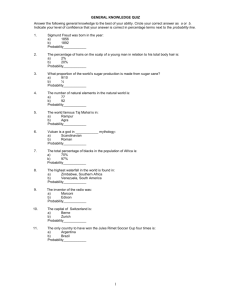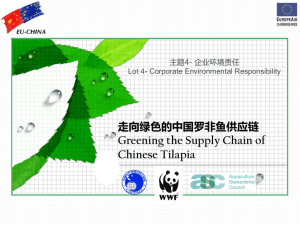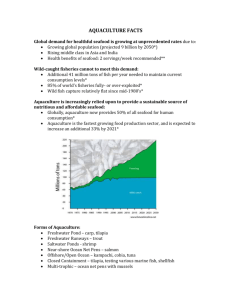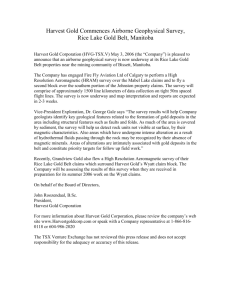Current status of tilapia aquaculture and processing in Zimbabwe
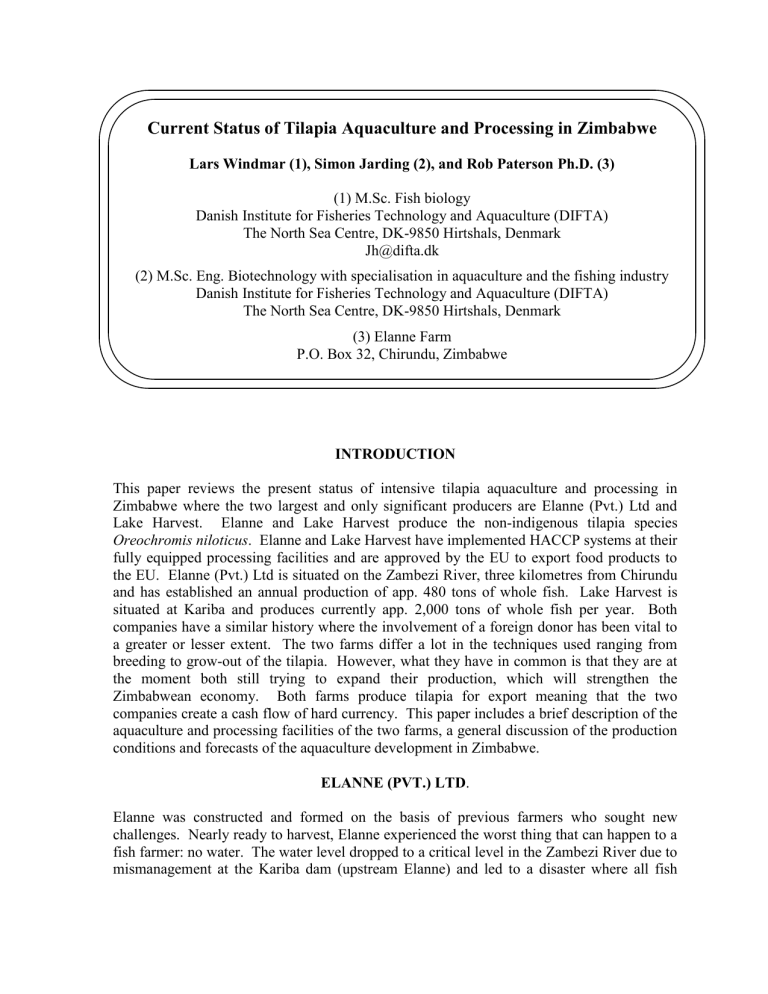
Current Status of Tilapia Aquaculture and Processing in Zimbabwe
Lars Windmar (1), Simon Jarding (2), and Rob Paterson Ph.D. (3)
(1) M.Sc. Fish biology
Danish Institute for Fisheries Technology and Aquaculture (DIFTA)
The North Sea Centre, DK-9850 Hirtshals, Denmark
Jh@difta.dk
(2) M.Sc. Eng. Biotechnology with specialisation in aquaculture and the fishing industry
Danish Institute for Fisheries Technology and Aquaculture (DIFTA)
The North Sea Centre, DK-9850 Hirtshals, Denmark
(3) Elanne Farm
P.O. Box 32, Chirundu, Zimbabwe
INTRODUCTION
This paper reviews the present status of intensive tilapia aquaculture and processing in
Zimbabwe where the two largest and only significant producers are Elanne (Pvt.) Ltd and
Lake Harvest. Elanne and Lake Harvest produce the non-indigenous tilapia species
Oreochromis niloticus . Elanne and Lake Harvest have implemented HACCP systems at their fully equipped processing facilities and are approved by the EU to export food products to the EU. Elanne (Pvt.) Ltd is situated on the Zambezi River, three kilometres from Chirundu and has established an annual production of app. 480 tons of whole fish. Lake Harvest is situated at Kariba and produces currently app. 2,000 tons of whole fish per year. Both companies have a similar history where the involvement of a foreign donor has been vital to a greater or lesser extent. The two farms differ a lot in the techniques used ranging from breeding to grow-out of the tilapia. However, what they have in common is that they are at the moment both still trying to expand their production, which will strengthen the
Zimbabwean economy. Both farms produce tilapia for export meaning that the two companies create a cash flow of hard currency. This paper includes a brief description of the aquaculture and processing facilities of the two farms, a general discussion of the production conditions and forecasts of the aquaculture development in Zimbabwe.
ELANNE (PVT.) LTD .
Elanne was constructed and formed on the basis of previous farmers who sought new challenges. Nearly ready to harvest, Elanne experienced the worst thing that can happen to a fish farmer: no water. The water level dropped to a critical level in the Zambezi River due to mismanagement at the Kariba dam (upstream Elanne) and led to a disaster where all fish
ready for harvesting were killed. This involved the Danish International Development Aid
(DANIDA) and an aid programme was initiated in 1997.
Elanne is currently producing app. 480 tons per annum and is aiming at reaching 1,200 tons within 1½ year. The factory is designed to take app. 1,200-1,600 tons/year depending on the type of product. Elanne´s freezing capacity is way over 1,600 tons/year and will not be a limiting factor during production. Elanne is currently trying to follow the market demands of frozen or fresh fillets. This seems to be the area where tilapia is eventually going to achieve a stable market position in Europe.
The aquaculture facilities at Elanne consist of breeding ponds, a Fry & Fingerling area and a raceway for ongrowing. The breeding area consists of 6 earth ponds with dimensions 15m x
40 m, depth 0.5-1m and two earth ponds with dimensions 10 x 90 m, depth 0.5-1 m.
Breeding takes place 8 months a year except May-August due to winter temperatures in
Zimbabwe. The 600 m
2
breeding pond is stocked with app. 800, 500 g females and app. 400,
700 g males. The breeding ponds are drained 21-24 days after stocking dependent on the water temperature and app. 100,000-280,000 fry are hand collected. The fry are transferred to the Fry & Fingerling area, which consists of 40, 40 m
3
concrete tanks organised in a serial reuse design where the recycled water is oxygenated in trickling filters. The fry are graded every 30 days, and slow growers are discarded. Stocking size fingerlings of 40-50 g/fish are produced in app. 4 months. The ongrowing raceway is a 650 m long canal divided into 5 compartments with dimensions of app. 85 m * 20 m * 2 m (L* W *D). The variations in the flow in the Zambezi River and hence the flow in the ongrowing canal are determined by power generation at the hydroelectric facility at Kariba dam. The flow in the canal is on average app. 1.7 m
3
/s.
In the ongrowing canal, tilapia are produced from fingerlings to a market size of 600-700 g in app. 8 months. The bulk of the production is sold as fresh or frozen fillets at the European market. The production in the ongrowing raceway is increased to facilitate a production of
1,200 tons of whole fish per year at Elanne farm by installation of propeller pumps with a capacity of 9 m
3
s
-1
at the inlet.
LAKE HARVEST
Lake Harvest differs from Elanne in many ways with regard to production methods but both systems seem to be working very well. At Lake Harvest breeding takes place 12 months a year and fry is sex reversed by adding hormones to the diet of the first eating fry. The fingerling area consists of large app. 1 m deep earth ponds, and the ongrowing facilities consist of net cages on Lake Kariba. The production at Lake Harvest is at the moment 2,000 tons per annum, and the aim is to reach a total production of 5,000 tons per annum. Lake
Harvest has a processing unit on the banks of Lake Kariba. The processing unit is of very high standard and is equipped with a laboratory that can make the required daily analyses within the implemented HACCP system.
PRODUCTION CONDITIONS IN ZIMBABWE
In order to establish a successful production of tilapia, requirements in relation to management/education and general infrastructure are equally important. It is of the utmost importance to have a steady supply of fish feed, packaging materials, power, cleaning materials, bits and pieces for repair and maintenance, etc. Logistics are for both farms very good, and due to considerable investments in freezer trucks there are no problems in transportation of frozen or fresh fish. The fresh fish are flown out of Harare Airport. The price for smaller amounts increases significantly, and it has been proven unfeasible to transport less than 500 kg fresh fish out of Zimbabwe. Frozen fish on the other hand are taken by ship to Europe or the US. The fish are transported in containers to an international port in South Africa or Mozambique from where the final destination is reached within app. 1 month.
Packaging Materials
Zimbabwe has a long tradition for exporting other food products than fish, and the country is therefore well equipped with suppliers of packaging materials which are also approved for the food industry. The packaging materials can be tailor made by appointment with the producers.
Education
There is currently no public education in aquaculture or fish processing in Zimbabwe, and all workers at Elanne and Lake Harvest must be trained on site. Lake Harvest is strongly supported by the Commonwealth Development Co-operation and has been fully equipped with experts within the fields of aquaculture and fish processing from the beginning of the project. The DANIDA programme at Elanne involves Danish aquaculture and processing experts who have trained the staff at Elanne since 1997. The workers at Lake Harvest and
Elanne are trained in various practical matters in aquaculture and processing of fish. Key workers are appointed and trained further. Furthermore, the two aquaculture units produce labour for both men and women.
EU Inspection
Zimbabwe is on the list of countries that are approved to export food products to the EU.
Having such an approval raises several demands from the exporting countries. Among others, Zimbabwe needs to have a local inspector who is trained by the EU to perform inspections in food production and therefore also fish production. The EU inspector in
Zimbabwe performs numerous tests on the tilapia and the water used in the processing units.
Fish and water are tested for hormones, pesticides, Coli forming bacteria, spoilage bacteria and staphylococcus and chemical parameters such as pH and other chemical parameters.
This inspection is currently carried out at a frequency of 14 days, which is a fairly high frequency.
FUTURE
The market for tilapia seems to increase both in the USA and the EU. Especially the
European market looks promising and has by Rain Forest and other commercial fish trading companies been described as very similar to the market in the USA 10 years ago. With such prospects the potential for tilapia seems unlimited in the near future. The increased export markets for tilapia are opening opportunities for producers in Zimbabwe and other tropical countries where climatic conditions are perfect for production of tilapia. In Zimbabwe in the
Zambezi river region where clean water with optimum temperatures for growth are available in excess, the costs of production of tilapia are substantially lower than the corresponding production costs of tilapia in indoor heated recirculating systems in Europe. It is only within the last 2 or 3 years that Zimbabwe has been able to export fish from factories approved by the appointed authorities to the EU. In the future this is an issue which will be extremely important for the producers of tilapia for exports, since this is their direct link to the world, and at this stage the demand for sufficient food safety programmes is essential.
Elanne and Lake Harvest farms will continue to expand their production and can for the time being not see any limitations if they look at the production with very optimistic eyes.
However, both farms are aware of the importance of setting milestones before reaching for the sky. In the near future Elanne and Lake Harvest are increasing their production of tilapia.
Elanne is expanding to an annual production of 1,200 tons within a period of 2 years, and
Lake Harvest is expanding to a production of 5,000 tons within a period of 3 years.
To the author's knowledge several people in Zimbabwe are considering starting the production of tilapia. Especially if it will be possible to process the fish at the approved factories that already exist in Zimbabwe.
Elanne and Lake Harvest produce a smaller amount for the local markets in Zimbabwe and
Zambia but this seems to be a small niche production and the big cash flow must come from hard currency. The future markets for tilapia produced in Zimbabwe are therefore inevitably
Europe and the US.
